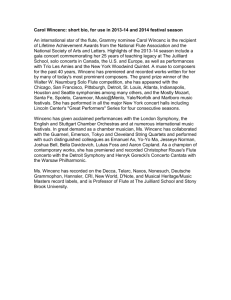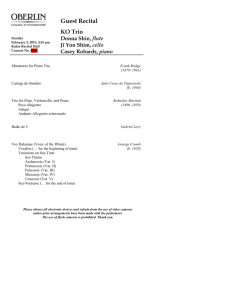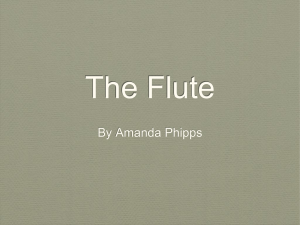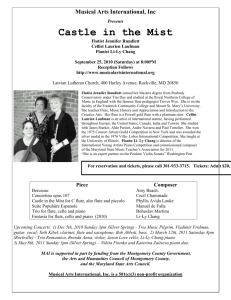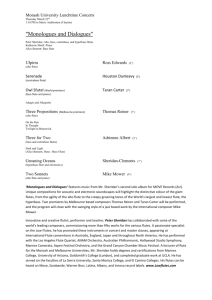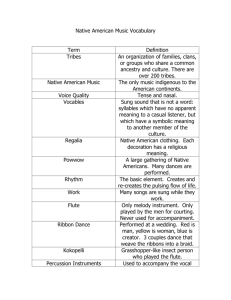profile – stephen carter - The Flute Society of South Australia Inc.
advertisement
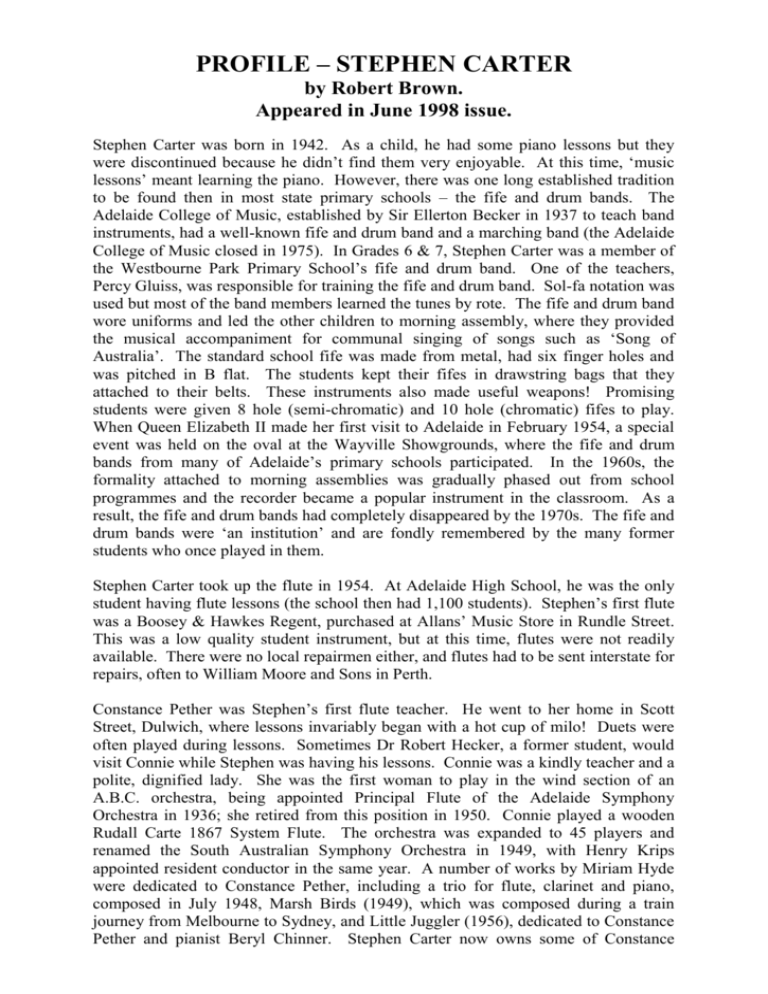
PROFILE – STEPHEN CARTER by Robert Brown. Appeared in June 1998 issue. Stephen Carter was born in 1942. As a child, he had some piano lessons but they were discontinued because he didn’t find them very enjoyable. At this time, ‘music lessons’ meant learning the piano. However, there was one long established tradition to be found then in most state primary schools – the fife and drum bands. The Adelaide College of Music, established by Sir Ellerton Becker in 1937 to teach band instruments, had a well-known fife and drum band and a marching band (the Adelaide College of Music closed in 1975). In Grades 6 & 7, Stephen Carter was a member of the Westbourne Park Primary School’s fife and drum band. One of the teachers, Percy Gluiss, was responsible for training the fife and drum band. Sol-fa notation was used but most of the band members learned the tunes by rote. The fife and drum band wore uniforms and led the other children to morning assembly, where they provided the musical accompaniment for communal singing of songs such as ‘Song of Australia’. The standard school fife was made from metal, had six finger holes and was pitched in B flat. The students kept their fifes in drawstring bags that they attached to their belts. These instruments also made useful weapons! Promising students were given 8 hole (semi-chromatic) and 10 hole (chromatic) fifes to play. When Queen Elizabeth II made her first visit to Adelaide in February 1954, a special event was held on the oval at the Wayville Showgrounds, where the fife and drum bands from many of Adelaide’s primary schools participated. In the 1960s, the formality attached to morning assemblies was gradually phased out from school programmes and the recorder became a popular instrument in the classroom. As a result, the fife and drum bands had completely disappeared by the 1970s. The fife and drum bands were ‘an institution’ and are fondly remembered by the many former students who once played in them. Stephen Carter took up the flute in 1954. At Adelaide High School, he was the only student having flute lessons (the school then had 1,100 students). Stephen’s first flute was a Boosey & Hawkes Regent, purchased at Allans’ Music Store in Rundle Street. This was a low quality student instrument, but at this time, flutes were not readily available. There were no local repairmen either, and flutes had to be sent interstate for repairs, often to William Moore and Sons in Perth. Constance Pether was Stephen’s first flute teacher. He went to her home in Scott Street, Dulwich, where lessons invariably began with a hot cup of milo! Duets were often played during lessons. Sometimes Dr Robert Hecker, a former student, would visit Connie while Stephen was having his lessons. Connie was a kindly teacher and a polite, dignified lady. She was the first woman to play in the wind section of an A.B.C. orchestra, being appointed Principal Flute of the Adelaide Symphony Orchestra in 1936; she retired from this position in 1950. Connie played a wooden Rudall Carte 1867 System Flute. The orchestra was expanded to 45 players and renamed the South Australian Symphony Orchestra in 1949, with Henry Krips appointed resident conductor in the same year. A number of works by Miriam Hyde were dedicated to Constance Pether, including a trio for flute, clarinet and piano, composed in July 1948, Marsh Birds (1949), which was composed during a train journey from Melbourne to Sydney, and Little Juggler (1956), dedicated to Constance Pether and pianist Beryl Chinner. Stephen Carter now owns some of Constance Pether’s music, including a manuscript copy of Marsh Birds, on which the composer drew an ink sketch of a marsh scene. In the mid 1950s, Connie was beginning to show the first stages of Alzheimers Disease, and eventually returned to her native city of Perth, where she died in 1965. In the late 1940s and early 1950s, classroom music in state schools consisted of singing and listening to music appreciation programmes broadcast by the A.B.C. The Public Schools Music Society presented its annual choral festivals. These had stopped during the war, but resumed in 1951. Stephen Carter remembers participating in a choral festival concert held at the Capri Theatre on Goodwood Road. The Education Department’s Music Branch was established in 1946, and began with a series of visits to schools by the then Superviser of Music, Alva Penrose. In 1949, two music teachers, Patricia Holmes and Jack Slee, were appointed to assist Penrose. John Bishop was installed as the 4th Elder Professor of Music in 1948 and soon recognised that the standards of both classroom and instrumental teaching in schools needed to be improved. He began by upgrading the music education courses on offer at the Elder Conservatorium. In 1961, David Bishop (a ‘cellist, and son of Prof. Bishop) was appointed to develop a programme of music tuition in state schools. He began by forming the Adelaide Trio with Erwin Meyer (violin) and Geoffrey Madge (piano), which toured primary schools. From these beginnings a team of instrumental and singing teachers was established to give instruction in state primary and secondary schools. David Cubbin arrived in Adelaide in 1954 to join the South Australian Symphony Orchestra. Stephen Carter began taking lessons with him as a single studies student at the Elder Conservatorium in 1959 while studying for an Economics Degree. Some of David Cubbin’s most advanced students at this time included Margaret Mullins and Rae Stratfold. Stephen Carter attended the National Music Camps held at Geelong Grammar in 1963 and St Peter’s College in 1964, when he was Principal Flute in the First Orchestra (John Bishop had founded the music camp movement in 1947; the first National Music Camp was held in 1948 at Port Lonsdale). Some of the flute students at the music camps viewed David Cubbin’s use of vibrato with suspicion, because it was a new concept to them and a possible cover-up for tonal deficiencies! Stephen Carter was a finalist in the 1965 A.B.C. Concerto and Vocal Competitions. In 1964, the A.B.C. enlarged the South Australian Symphony Orchestra again and more women joined the orchestra’s ranks. The number of permanent flute positions was increased from two to three players. Stephen Carter was appointed Second Flute during the 1964 Adelaide Festival and joined David Cubbin, Principal Flute, and Joseph Brunovsky, Third Flute and Piccolo. David Cubbin played Principal Flute for the last time at a Festival concert held in the Regent Theatre. He left the orchestra to become a full-time lecturer at the Elder Conservatorium and a foundation member of the University of Adelaide Wind Quintet. Russell King was then appointed Principal Flute. In the mid 1960s, the plateau model Böhm System flute was being used by many professional flautists. Some players were changing to the Böhm System flute from the Radcliff and 1867 System flutes. Russell King’s open hole B-foot silver Vérémy Tibouville-Lamy flute was one of the first instruments of this type to be seen in Adelaide. Margaret Crawford was using an open-hole Gemeinhardt flute at about this time. Some professional players at this time were using the open G# Böhm flute, including Neville Amadio, Colin Evans and Paul Curtis (Sydney Symphony Orchestra) and Owen Fisenden (West Australian Symphony Orchestra). Orchestral rehearsals were held in the A.B.C. buildings located on the south-eastern corner of Hindmarsh Square and Grenfell Street for many years. These buildings were erected in 1865 for the Congregational Church, and were acquired by the A.B.C. in 1935 (the buildings were demolished in 1982). The conditions at Hindmarsh Square were appalling. The orchestral studio was very hot, so ceiling fans were used for cooling which meant that the musicians had to use pegs to stop their music blowing away, even during recording sessions! In the late 1960s, the orchestra moved to the Odeon Theatre on the corner of Queen Street and The Parade, Norwood, and from there to the purpose built studios at Collinswood in 1972. Russell King and Joseph Brunovsky had thoroughly absorbed the great musical traditions while playing in English and Hungarian orchestras. We are isolated here in Australia and far away from the major centres of music making. Stephen Carter acknowledges that he learned a great deal from Russell and Joe during his early years in the orchestra. Jean-Pierre Rampal toured for the A.B.C. in 1966 and impressed everyone with his wonderful musicianship. Australian flautist Douglas Whittaker, then Co-Principal Flute of the B.B.C. Symphony Orchestra, toured in 1969 and displayed a no-nonsense, thoroughly professional and polished style every time that he rehearsed or performed. The University of Adelaide Wind Quintet was another important influence for wind players at this time. James Pellerite visited Adelaide in 1973 and was a study in cultured playing. James Galway performed with the Adelaide Symphony Orchestra in 1977 and 1980 and brought his Irish charm and showmanship. Others to tour included the Australian flautists John Wion, Principal Flute of the New York City Opera Orchestra, and our own David Cubbin. By the late 1960s, flutes were becoming readily available at Adelaide’s music houses. Brands at this time included Armstrong, Gemeinhardt and Muramatsu, with De Ford and Yamaha flutes becoming available in the early 1970s. The first flutes made by Australian flute maker John Lehner appeared in the mid 1970s. Stephen Carter taught at the Elder Conservatorium in the late 1960s. The Flinders Street School of Music was established in 1970 and employed Stephen on a part-time basis as the first part-time flute teacher. Eventually, due to increased demand for tuition, Joseph Brunovsky was also employed as a part-time flute teacher at Flinders Street. In 1972, George Hooker, then the Head of the Flinders Street School of Music, decided to appoint a full-time flute teacher and offered the position to both Stephen Carter and Joseph Brunovsky. They both declined, because this meant having to leave the orchestra, which they didn’t wish to do. Judy Cooper was appointed full-time flute teacher at Flinders Street. By 1973 she had gone to live in New Zealand and was suceeded by Alison Rosser. In the 1960s, A.B.C. Choral and Youth Concerts were very popular. Young people would camp all night in Gawler Place near the A.B.C.’s ticket office (this was closed some years ago) to be sure of obtaining tickets when the doors opened. The orchestra also made many country tours. By the early 1970s, the Choral and Youth Concerts had disappeared and the country tours reduced considerably. The disbanding of the Adelaide Singers in February 1976 was a real loss. Concert programming tended to be very conservative in the 1960s and 1970s. Joseph Brunovsky died suddenly in September 1973. Stephen Carter became Third Flute and Piccolo in 1974 and Elizabeth Koch joined the orchestra as Second Flute. The orchestra reverted to its original name, the Adelaide Symphony Orchestra, in 1975. Russell King retired in 1979 and Neil Fisenden succeeded him as Principal Flute. Neil returned to his home town, Perth, in late 1983 to become Principal Flute in the West Australian Symphony Orchestra. Auditions were held and in 1984, Stephen Carter was appointed Principal Flute of the Adelaide Symphony Orchestra, a position that he still holds. Over the years, Stephen Carter has played under many conductors. Henry Krips was the resident conductor of the South Australian Symphony Orchestra. Regular visitors to Adelaide included Rudolf Pekarek (Queensland Symphony Orchestra), George Tzipine (Melbourne Symphony Orchestra) and Sir Bernard Heinze, who was Director of the N.S.W. Conservatorium and father of the A.B.C.’s Youth Concerts. International conductors have included Tibor Paul, Dean Dickson, Willem van Otterloo and Andre Cluytons. Soloists who left a lasting impression have included the young Daniel Barenboim, sopranos Janet Baker and Jessye Norman, pianists Rudolf Serkin, Moura Lympany and Alfred Brendel, violinists Ruggiero Ricci and Alfredo Campoli, and ‘cellists Andre Navarra and Paul Tortellier. The Flute Society of South Australia’s inaugural meeting in July 1972 included ‘An Evening of Various Examination Works’. Leading Adelaide flautists were asked to give performances of and discuss works from the A.M.E.B. repertoire. These included Alison Rosser, Helen Fairhall, Russell King, Judy Cooper, Stephen Carter and David Cubbin. Russell King and Stephen Carter gave a duo recital for the Flute Society in the S.A.I.T. Hall on March 7th, 1973. They were joined by colleagues Audrey White, piano, and Rosemary St John, harp. The programme included music by Loeillet, Mozart, Beethoven, Berlioz, Hindemith and Doppler. The Adelaide Flute Quartette was active in the 1970s. Its members were Russell King, Stephen Carter, Elizabeth Koch and Sue Hackett. They gave a performance for the Flute Society in Edmund Wright House on February 28th, 1977. Stephen Carter has given masterclasses for the Flute Society on a number of occasions and adjudicated the Carolyn White Memorial Scholarship in 1995. He is an examiner for the A.M.E.B. and the Elder Conservatorium, and also takes private pupils. Stephen Carter remains open minded and interested in the tonal properties of the different metals used in flute making. Are precious metals only entrusted to the best craftsmen and therefore give the best results? Is it only a question of getting the design right, i.e. the geometry of the embouchure hole and headjoint, etc.? Why are seamed tubes on top quality flutes so popular? Does it make a difference and if so, how? Another puzzle is the high cost of flutes in Australia. Items such as extruded tubing are easily obtainable from tube manufacturers. Top quality oboes, which have a far more complicated key work than flutes, and pairs of good quality clarinets, can be bought for much less than the price of good quality flutes. Why is this? Stephen Carter is married and has five daughters ranging in age from 24 to 13 years. His eldest daughter is training to be a physician. The second daughter is a ‘cellist, studying with Chris Handley from the Adelaide Symphony Orchestra, and the third daughter, a trained nurse, works at the Royal Adelaide Hospital. She is studying the harp with Rosemary St John, formerly of the Adelaide Symphony Orchestra, at the Elder Conservatorium for a music degree. The youngest two daughters are still at school. About two years ago, after the death of harp maker Peter Kempster, the Carter family began selling student model harps, harp strings, harp music and harp accessories throughout Australia. Sources of Information Stephen Carter and Alison Rosser. The Language Of Human Feeling, History of Music In The University Of Adelaide. V.A. Edgeloe, 1985. Cause to Rejoice. The Life of John Bishop. Awdrey Hewlett. Rigby, 1983. John Bishop, A Life for Music. Christopher Symons. Hyland House, 1989. From Colonel Light Into The Footlights. The Performing Arts in South Australia from 1836 to the Present. Edited by Andrew McCredie. Pagel, 1988. School Fife Tutor. Frank L. Gratton. Allans. Complete Accord. Miriam Hyde. Currency Press, 1991. Lost Adelaide. A Photographic Record. Michael Burden. Oxford University Press, 1983.
